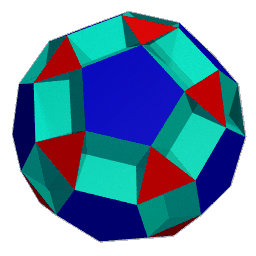
The Uniform Polyhedra
Contents
Uniform polyhedra
consist of regular faces and congruent vertices.
Allowing for non-convex faces and vertex figures, there are 75 such polyhedra, as well as 2 infinite families of prisms and
antiprisms.
A recently discovered uniform way of computing their vertex coordinates
[Harel93]
is the basis for a program to display all of these solids,
among which are many beautiful and stunning shapes.
This text is an excerpt of Chapter 9 of
R. Maeder's book The Mathematica Programmer II.
An expanded version of these Web pages can also be found in
the Mathematica notebook Polyhedra.ma from the
Illustrated Mathematics CD-ROM.
The metric properties and graphics data were computed with a
Mathematica
program,
developed by R. Maeder, based on a C program by Zvi Har'El.
The ray-traced images on these pages were rendered with
POV-ray,
from data computed with the program mentioned above,
using a conversion program
from Mathematica graphics format to
POV-ray input.
Programs and Images are Available!
 The Mathematica programs to compute and render the polyhedra
are included on the CD-ROM that comes with
The Mathematica Programmer II.
The book contains also high-resolution color images of all uniform polyhedra.
Follow the link to the book's home page
for more information and
direct ordering in association with amazon.com.
The Mathematica programs to compute and render the polyhedra
are included on the CD-ROM that comes with
The Mathematica Programmer II.
The book contains also high-resolution color images of all uniform polyhedra.
Follow the link to the book's home page
for more information and
direct ordering in association with amazon.com.
Graphic Resources
There is one page for each polyhedron with a high-resolution image
and geometrical information. The pages can be accessed in these ways:
 A visual index (sensitive map) of all 80 polyhedra
A visual index (sensitive map) of all 80 polyhedra
 List and thumbnail pictures of all Uniform Polyhedra
List and thumbnail pictures of all Uniform Polyhedra
 A
list sorted by Wythoff symbol
A
list sorted by Wythoff symbol
 A guided tour of all 80 polyhedra starts here
A guided tour of all 80 polyhedra starts here
Animations
See the polyhedra spin about a symmetry axis for better visualization.
The animations are linked through the high-resolution images on the
individual polyhedra pages.
This listing indicates which type of symmetry the polyhedron has:
dihedral, tetrahedral, octahedral, and icosahedral.
The listing does not indicate whether the polyhedron possesses full
(reflective) symmetry, or only rotational symmetry (most snub polyhedra).
The vertex configuration is the sequence of faces arranged around a vertex.
Since vertices are congruent, this sequence is the same for all vertices.
A regular n-sided polygon (an n-gon) is described by n.
Star polygons are described by n/d, where n is the number of vertices, connected d apart.
For example, 5/2 is the pentagram.
Some polyhedra contain retrograde faces.
For example, 4/3 is a square, traversed in the opposite direction.
A regular 2-gon is degenerate and can be left out if it occurs in the formulae.
 You may also want to have
a look at the collection of all stellated icosahedra.
You may also want to have
a look at the collection of all stellated icosahedra.
 Programs and high-resolution images for uniform polyhedra are available in
the book The Mathematica Programmer II by R. Maeder.
Programs and high-resolution images for uniform polyhedra are available in
the book The Mathematica Programmer II by R. Maeder.
 All 75 uniform polyhedra, with background information, a clickable map, and animations.
All 75 uniform polyhedra, with background information, a clickable map, and animations.
A service provided by MathConsult AG, http://www.mathconsult.ch/.
© Copyright 1995, 1997 by Roman E. Maeder. All rights reserved.

 You may also want to have
a look at the collection of all stellated icosahedra.
You may also want to have
a look at the collection of all stellated icosahedra.
 Programs and high-resolution images for uniform polyhedra are available in
the book The Mathematica Programmer II by R. Maeder.
Programs and high-resolution images for uniform polyhedra are available in
the book The Mathematica Programmer II by R. Maeder.
 All 75 uniform polyhedra, with background information, a clickable map, and animations.
All 75 uniform polyhedra, with background information, a clickable map, and animations.